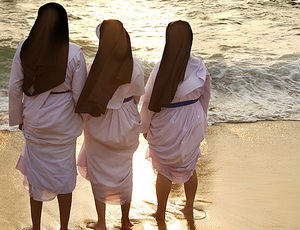Robyn Cadwallader is a new novelist, and The Anchoress is a delight. Sarah, a cloth merchant's daughter in 1255, is looking to escape the anguish of her sister's death and the predations of the local lord's son. This leads her to vows as anchoress, a holy woman contained in a nine-paces-by-five-paces cell, never to emerge. As much as Sarah tries to leave the world behind, it keeps flooding in, whether through the requests for prayers from the village women or the lordling who can't seem to take no for an answer. The book also deals with Father Ranaulf, her confessor and eventual coconspirator against the tyranny of the local nobility. Being locked away in an anchorage might seem dull and not good fiction material, but it's great if you like deep characters. Sarah tries to live by her Rule and nearly dies doing it, but eventually finds her place in the community, which is not as peripheral as one might think. The Anchoress is very well-researched and gives us a woman that is believable for both her time and ours. This is a great book for complex characters and ideas. Cadwallader leaves open the possibility of a sequel, and I am hoping for it.
Celebrated herbalist, songwriter and saint, Hildegard von Bingen did not have an auspicious beginning. From the age of eight and for thirty years, she was a maid and companion to an anchoress is Germany because her parents could not afford her dowry. Upon the anchoress' death, Hildegard emerged from the anchorage with a knowledge of herbs and a determination to look at religious life from a perspective of love instead of suffering. This was partly due to her visions, which also inspired her to compose hymns. Mary Sharratt covers these details, along with Hildegard's forming of the first female religious order in Germany, in her novel Illuminations. If you like historicals with small casts, deep themes, and luminous period detail, Sharratt's book may be for you.
Moving closer to the 21st century, Luis Alberto Urrea has written a novel about his great-aunt, Theresita: The Hummingbird's Daughter. A girl of very humble birth, Theresita learns herbalism and other healing arts from a curandera, or medicine woman. Raped and apparently killed as a teenager, she rises from the dead at her wake and announces it just isn't her time. This engenders thousands of pilgrims overrunning the ranch where she lives and a political rebellion against the corrupt Mexican government. Eventually, Theresita is banished to the United States, where her story continues in Queen of America. The Hummingbird's Daughter describes life on a 19th-century Mexican ranch and also the political dynamics of that time and place in addition to Theresita's singular narrative. There are elements of humor and magical realism as well. Like your female protagonists strong and unconventional? This is your novel.




Add a comment to: Holy Women, Batman! Women Religious in Historical Fiction